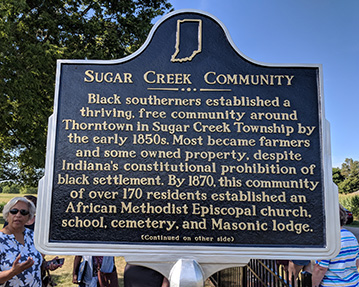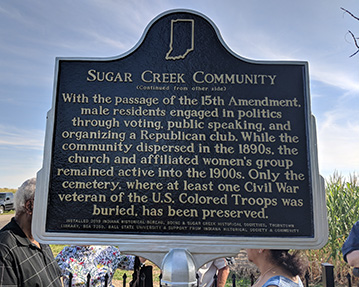

Location: Colored Cemetery location, 6770 North 825 West, Thorntown, Indiana 46071
Installed 2019 Indiana Historical Bureau, Boone & Sugar Creek Historical Societies, Thorntown Library, BSA T350, Ball State University & Support from the Indiana Historical Society & Community
ID#: 06.2019.1
![]() Visit the Indiana History Blog to learn more about "Race, Power, and the Ballot" in this early Black settlement.
Visit the Indiana History Blog to learn more about "Race, Power, and the Ballot" in this early Black settlement.
Text
Sugar Creek Community
Side One
Black southerners established a thriving, free community around Thorntown in Sugar Creek Township by the early 1850s. Most became farmers and some owned property, despite Indiana’s constitutional prohibition of black settlement. By 1870, this community of over 170 residents established an African Methodist Episcopal church, school, cemetery, and Masonic lodge.
Side Two
With the passage of the 15th Amendment, male residents engaged in politics through voting, public speaking, and organizing a Republican club. While the community dispersed in the 1890s, the church and affiliated women’s group remained active into the 1900s. Only the cemetery, where at least one Civil War veteran of the U.S. Colored Troops was buried, has been preserved.
Summary
Starting in the 1840s, Black families began settling in Boone County, Indiana.* One of the first to immigrate here from North Carolina was patriarch Moody Gilliam and family, who were relatives of nearby Roberts Settlement resident. It is likely that this proximity to family and a community led by Black settlers influenced the Gilliam family’s decision to settle in Boone County (but not Sugar Creek Township). More families arrived in the county in the late 1840s and 1850s and began farming. Despite their accomplishments, these new Boone County residents were not allowed to vote and may have been forced to register with county authorities and post a $500 bond. In fact, Indiana made it clear that these hardworking Black farmers were not welcome at all. In 1851, the Hoosiers voted for Article XIII of the Indiana Constitution that stated, "No negro or mulatto shall come into, or settle in the State..." Despite racist legislation and prejudice, these Black Hoosiers established a successful farming community in Sugar Creek Township near Thorntown. Some even owned land despite the constitutional prohibition against Black settlement.
By 1860, seventy-two Black settlers lived in Sugar Creek Township with eleven based in Thorntown proper. The census from that year, shows that they arrived mainly from North Carolina and Kentucky, that they were predominately farmers, and that most could not read and write. Many Black Southerners were prohibited from obtaining an education, as it was seen by white slaveholders as a threat to the slavery system. The mainly illiterate founders of the Sugar Creek settlement, however, broke this systematic oppression by making sure their children could read and write. By the late 1860s, Sugar Creek’s Black residents purchased land from local Quakers for the purpose of building a school. Around the same time, they also purchased a lot to build an African Methodist Episcopal church. The church established a Sabbath school around 1869. Thus, the children of the Sugar Creek founders received a primary education as well as a spiritual one. Also in 1869, residents purchased more Quaker land to establish a “burying ground for the Colored people of Thorntown and vicinity.” By the late 1860s, the Sugar Creek community also boasted a Masonic lodge.
During the Civil War, at least one Sugar Creek son fought for the Union cause in the 55th Massachusetts Infantry Regiment of the United States Colored Troops. It’s not clear when Elijah Derricks came to Sugar Creek, but he is buried in the “colored cemetery." Derricks volunteered for service in 1863 when he was 38-years-old. His regiment saw a great deal of action in Florida and South Carolina and he was injured in his arm at the Battle of Honey Hill.
After the passage of the Fifteenth Amendment gave Northern Black men the right to vote in 1870, the Black men of the Sugar Creek community immediately joined the political efforts and causes of the time. The founded a political club in support of the Republican presidential ticket in 1872 and newspapers provide evidence that local politicians sought their votes and support. By 1870, 172 Black Hoosiers lived in Sugar Creek Township, seventy-seven of whom lived in Thorntown. The A.M.E. church had twenty-five adult congregants by 1874 and forty-five children in Sunday school. By 1879, Sugar Creek men served on juries and by the 1890s the A.M.E. church served as the local polling place. By the late 1890s, many in the Sugar Creek community had moved to Lebanon or surrounding towns for more employment opportunities. However, the Thorntown church stayed active for several more decades. Today, the cemetery is the only physical remnant of this community, established and led by Black Hoosiers who thrived in Thorntown and Sugar Creek for generations.
*Note on Terminology: The term “Black” is used here as opposed to “African American” because it provides the necessary ambiguity to describe the Sugar Creek settlers. Some family names at Sugar Creek are the same as residents of Roberts Settlement and thus likely relatives. Many Roberts residents either had no African heritage or very distant and thus did not identity as “African American.” Describing the Sugar Creek settlers as “Black” is more inclusive of the possibility that Sugar Creek residents had the same heritage as Roberts residents.
Annotated Text
Side One
Black southerners established a thriving, free community around Thorntown in Sugar Creek Township by the early 1850s.[1] Most became farmers and some owned property, despite Indiana’s constitutional prohibition of black settlement.[2] By 1870, this community of over 170 residents established an African Methodist Episcopal church, school, cemetery, and Masonic lodge.[3]
Side Two
With the passage of the 15th Amendment, male residents engaged in politics through voting, public speaking, and organizing a Republican club.[4] While the community dispersed in the 1890s, the church and affiliated women’s group remained active into the 1900s.[5] Only the cemetery, where at least one Civil War veteran of the U.S. Colored Troops was buried, has been preserved.[6]
[1]1850 United States Census, District 7, Boone County, Indiana, Roll 136, National Archives Microfilm Publication M432, 1009 rolls, Records of the Bureau of the Census, Record Group 29; National Archives, Washington, D.C., accessed AncestryLibrary.com.
Of the 11,631 people in Boone County, 20 people of color were documented by the 1850 U.S. Census. There were likely more Black residents than were officially counted.
[2] Ibid.; Article 13, Indiana Constitution of 1851 in Charles Kettleborough, ed., Constitution Making in Indiana, vol. 1, (Indianapolis: Indiana Historical Bureau, 1916), accessed Indiana Historical Bureau website, in.gov/history; 1860 United States Census, Thorntown, Boone County, Indiana, NARA microfilm publication M653, 1,438 rolls. Washington, D.C.: National Archives and Records Administration, accessed AncestryLibrary.com.
In 1851, Hoosiers voted for Article XIII of the Indiana Constitution that stated, “No negro or mulatto shall come into, or settle in the State, after the adoption of this Constitution.” Despite racist legislation and prejudice, Black settlers established a successful farming community in Boone County concentrated in Sugar Creek Township near Thorntown. By 1860, seventy-two Black Hoosiers lived in Sugar Creek Township with eleven based in Thorntown proper. The census from that year, shows us that they arrived mainly from North Carolina and Kentucky and that they were predominately farmers.
[3] Sources in this note submitted by applicant with copies in the IHB marker file (unless otherwise noted). Deed Record Book 15, Records of Boone County Recorder’s Office; “Colored Masonic Lodge,” Lebanon Patriot, March 26, 1868, 4; Crawfordsville Weekly Journal, July 9, 1868, 3; Letter to Editor, Lebanon Patriot, March 18, 1869, 3; “Boone County Sabbath School Association,” Lebanon Patriot, October 28, 1869, 2; Certificate of Election of the Trustees of Colored School and Church of Sugar Creek, August 4, 1870, Boone County, Indiana, Court Records Collection, Lebanon Public Library.
[4] “XVth Amendment Celebration at Thorntown,” Lebanon Patriot, September 1, 1870, 3, submitted by marker applicant, copy in IHB marker file; Lebanon Patriot, September 15, 1870, 3, submitted by marker applicant, copy in IHB marker file; Lebanon Patriot, August 8, 1872, 3, NewspaperArchive.com; “Seventh District News,” Crawfordsville Weekly Journal, August 15, 1872, 4, Hoosier State Chronicles; “Thorntown Items,” Lebanon Pioneer, July 19, 1877, 3, NewspaperArchive.com; Lebanon Pioneer, November 27, 1879, 3, NewspaperArchive.com; “The Negro Exodus,” Lebanon Weekly Pioneer, February 5, 1880, 2, NewspaperArchive.com; Thorntown Argus, November 3, 1894, 8, submitted by applicant, copy in IHB marker file; “Here Is News for You!” Thorntown Argus, March 6, 1897, 8, NewspaperArchive.com; Jill Weiss Simins, “Race, Power, and the Ballot: Early Black Settlement in Sugar Creek Township,” Indiana History Blog, June 3, 2019, https://blog.history.in.gov/race-power-and-the-ballot-early-black-settlement-in-sugar-creek-township/.
[5] “Vital Statistics,” Lebanon Pioneer, April 14, 1898, 1, NewspaperArchive.com; Thorntown Argus, May 14, 1898, 1, submitted by applicant, copy in IHB marker file; “Local and Personal,” Thorntown Argus, May 4, 1901, 1, NewspaperArchive.com; “Thorntown,” Indianapolis Recorder, January 11, 1902, 5, Hoosier State Chronicles; “Thorntown,” Indianapolis Recorder, February 22, 1902, 5, Hoosier State Chronicles; “Thorntown,” Indianapolis Recorder, April 19, 1902, 3, Hoosier State Chronicles; “Thorntown,” Indianapolis Recorder, April 26, 1902, 3, Hoosier State Chronicles; “Thorntown,” Indianapolis Recorder, May 3, 1902, 3, Hoosier State Chronicles; “Thorntown,” Indianapolis Recorder, May 10, 1902, 3, Hoosier State Chronicles; “Thorntown,” Indianapolis Recorder, May 17, 1902, 3, Hoosier State Chronicles; L. M. Crist, History of Boone County Indiana (Indianapolis: A. W. Bowen & Company, 1910), 225, accessed GoogleBooks; “Camp Meeting at Thorntown,” Indianapolis News, August 6, 1910, 13, NewspaperArchive.com; “County Reports Loss in School Children,” Lebanon Pioneer, May 7, 1914, 2, NewspaperArchive.com; “Mechanicsburg,” Lebanon Pioneer, July 13, 1916, 15; 1930 United States Census, Thorntown, District 18, Boone County, Indiana, FHL microfilm: 2340313, Fifteenth Census of the United States, 1930. Washington, D.C.: National Archives and Records Administration, 1930, T626, 2,667 rolls, accessed AncestryLibrary.com.
By 1930, only eight Black residents remained in Thorntown out of a population of 2,160 people.
[6] Elijah Derricks, 55th Regiment Massachusetts, United States Colored Infantry, National Archives, Compiled Military Service Records of Volunteer Union Soldiers Who Served with the United States Colored Troops, Microfilm Serial: M1801, Microfilm Roll 16, Accessed AncestryLibrary.com; “Boone County Pensioners,” Lebanon Weekly Pioneer, October 11, 1883, 1, submitted by applicant, copy available in IHB marker file; “List of Soldier Dead of All Wars Buried in Boone County,” Lebanon Reporter, May 27, 1926, 8, submitted by applicant, copy available in IHB marker file; “Pieces of History,” Lebanon Reporter, September 23, 2017, accessed http://eagleproject.homestead.com/.
Keywords
Early Settlement, African American
